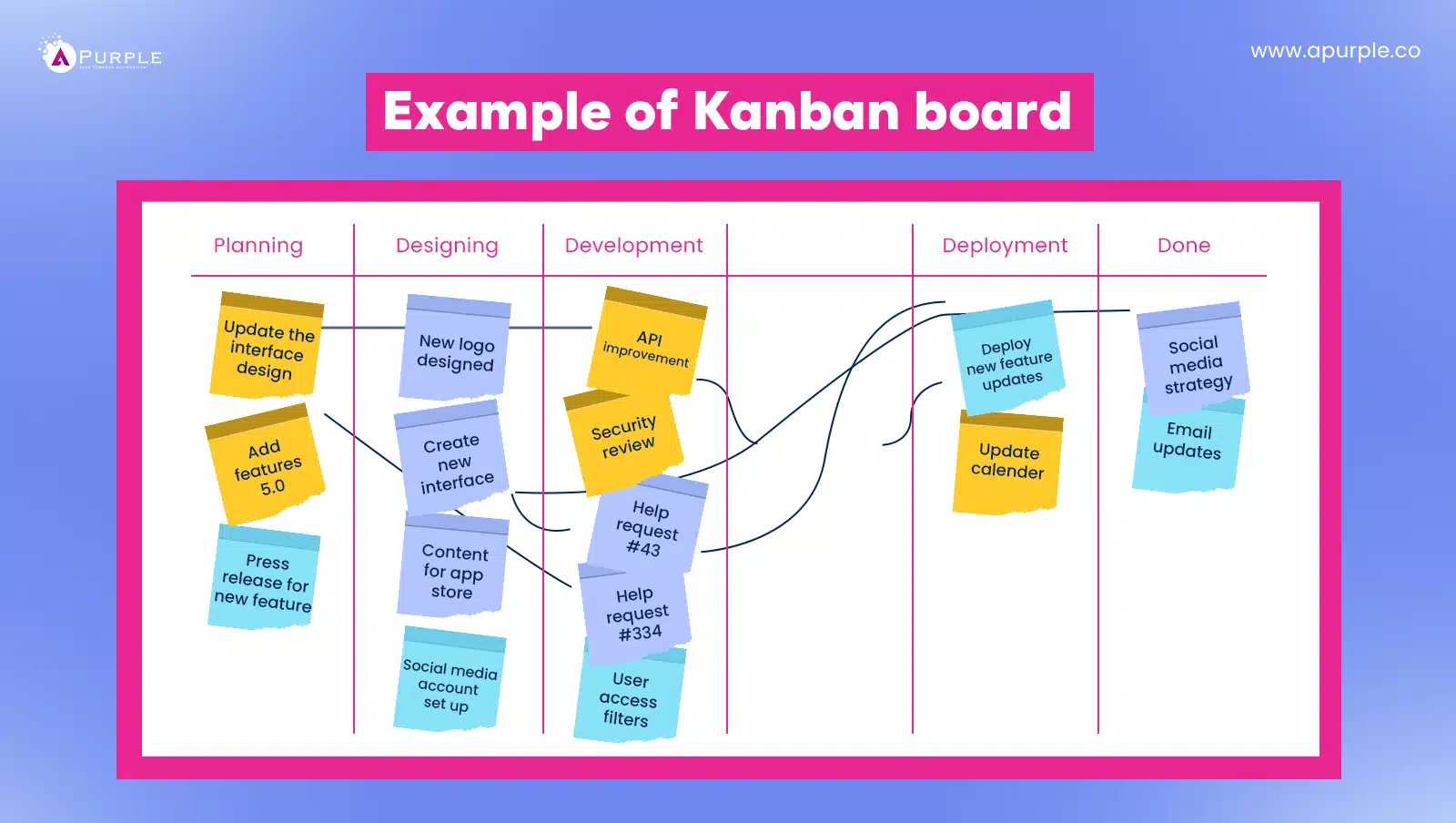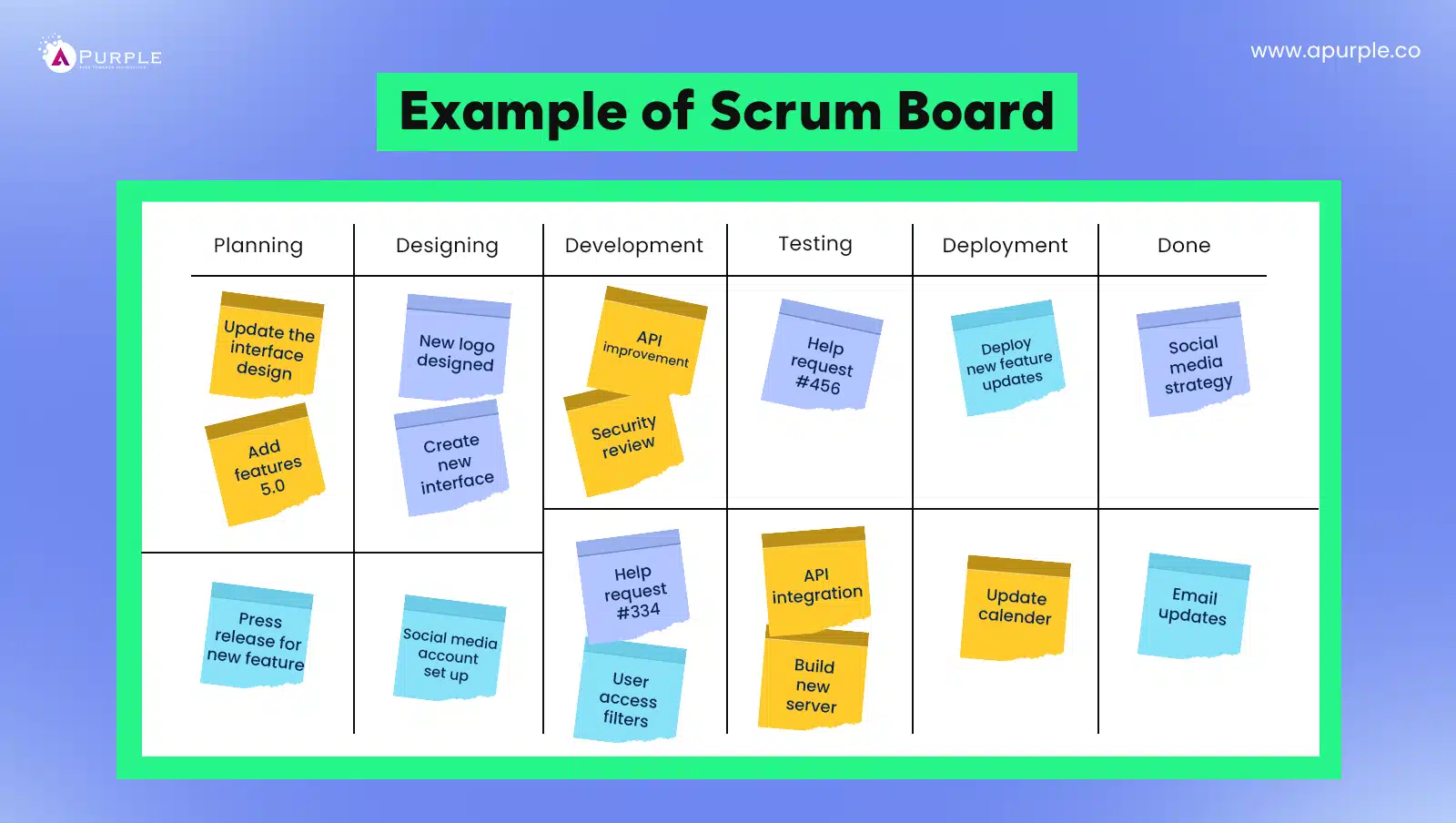
Ever wondered why teams keep debating Kanban vs. Scrum? When it comes to Agile project management, these two frameworks dominate the conversation. Giants in tech, software, and even marketing rely on them to plan work, boost collaboration, and deliver results faster.
But when you look closer, the Kanban vs. Scrum differences aren’t just about boards and sprints; they reflect two very different ways of managing work. Kanban thrives on flexibility and continuous flow, while Scrum pushes teams into focused, time-boxed sprints.
With Agile adoption on the rise, knowing which approach fits your team can be the difference between smooth progress and constant roadblocks. This article focuses on the pros and cons of both frameworks, their differences, and which is best for your startup project.
But first, you need to understand Kanban and Scrum separately!
What is Kanban in Agile Project Management?

If you’ve ever compared Scrum vs. Kanban, you’ll notice that Kanban is the more flexible option in agile project management. Instead of sticking to strict timelines, a Kanban team uses visual boards to map every task. These tasks move from “To Do” to “In Progress” and finally “Done,” giving everyone a clear picture of progress.
Kanban has its roots in Toyota’s production system, where engineers created a simple way to manage work efficiently and reduce waste. This Lean principle later evolved into modern Kanban boards that teams use today, making them highly effective in software product development as well as other industries.
The key features of Kanban include
- Visual workflow boards that show tasks clearly
- Work in progress (WIP) limits to avoid overload
- Continuous flow, so new tasks can enter as capacity allows
For example, in a marketing project, one campaign might be in the “In Review” stage, while another is “In Progress.” The team can see exactly what’s happening and quickly adjust priorities without pausing everything.
What are the Pros and Cons of Kanban?
Like any framework in Agile project management, Kanban has its strengths and weaknesses. A Kanban team often enjoys more flexibility than Scrum, but that freedom also comes with some challenges. Here’s a quick look at both sides:
Pros of Kanban
- Flexible; tasks can be added or updated anytime without disrupting the flow
- Visual boards make progress and bottlenecks easy to track
- Encourages continuous improvement through small, frequent updates
- Limits work in progress (WIP) so teams don’t get overloaded
Cons of Kanban
- No fixed time-boxing, which can slow down delivery for time-sensitive projects
- Lacks clearly defined roles compared to Scrum (no Scrum Master equivalent)
- It can become confusing if too many tasks pile up on the board
What is Scrum in Agile Project Management?
When people talk about Scrum vs. Kanban in Agile project management, Scrum is usually the more structured option. Scrum organizes work into short, focused periods called sprints, where teams aim to deliver specific results within a set time frame. Each sprint is guided by clear roles, with the Scrum Master ensuring the team stays on track and follows the framework.
The key features of Scrum include
- Time-boxing: work happens in fixed sprints, often 1–4 weeks
- Scrum roles: product owner, development team, and Scrum Master
- Artifacts: product backlog, sprint backlog, and increment
- Sprint cycle: planning, daily stand-ups, review, and retrospective
For example, in a software development project, a team might dedicate a two-week sprint to designing and testing a new feature. The Scrum Master facilitates daily stand-ups, helps remove blockers, and ensures everyone is aligned until the sprint goals are achieved.
What are the Pros and Cons of Scrum?
Scrum is one of the most popular frameworks in Agile project management, and for good reason. With structured sprints and clear roles, like the Scrum Master, it helps teams stay focused and accountable. But like Kanban, Scrum also comes with trade-offs.
Pros of Scrumn
- Structured sprints make complex projects manageable
- Clear roles and responsibilities increase team accountability
- Short cycles provide quick wins and measurable progress
- Keeps everyone aligned, especially useful in agile app development projects
Cons of Scrum
- Can feel rigid since priorities rarely change mid-sprint
- Requires heavy planning and oversight, which adds extra overhead
- Teams may struggle if even one member falls behind, slowing down the sprint
What are the Main Differences Between Kanban and Scrum?
Understanding the difference between Scrum and Kanban helps teams decide which framework fits their workflow best. While both are popular in Agile project management, they serve different purposes. Here’s a clear breakdown of Scrum vs. Kanban for easy comparison:
| Differentiators | Scrum | Kanban |
|---|---|---|
| Roles & responsibilities | Pre-define roles for individuals in the team, e.g., Scrum master, product owner, and development team | There are no roles defined for individuals |
| Iteration length | Fixed-length sprint (two to four weeks) | Follow a continuous flow approach |
| Working method | Solve problems through sub-tasks | There is no sub-task to solve problems |
| Task ownership | The team owns the sprint backlog | Multiple teams share the Kanban board |
| Transparency | Transparent and inspectable | Predictable and Efficient |
| Process Flow | The process is smooth when a team member leaves in between sprints. | The flow is interrupted if a team member leaves in between. |
| Project type | Works perfectly for projects with changing priorities. | Works perfectly for projects with stability priorities. |
| Problem-solving | Only the Scrum Master solves the problem. | All the members are allowed. |
| Resources | It is not recommended if resources are limited. | Recommended if tasks and resources are limited. |
| Tools & Software |
|
|
In Short, the difference between Kanban and Scrum lies in flexibility, roles, workflow, and measurement. Kanban boards are perfect for continuous tasks and fast changes, while Scrum sprints give structure, accountability, and focus for teams, especially in MVP mobile app development projects.
Which is Better: Kanban or Scrum?
Deciding between Kanban vs. Scrum isn’t about one being “better” than the other; it’s about what works best for your team and project. Both frameworks in Agile project management have their strengths, and the right choice depends on several key factors:
Project Type
- Use Kanban for continuous flow work, like marketing campaigns or content production.
- Use Scrum for structured cycles with defined goals, like software development sprints.
Team Size & Dynamics
- Small or self-managing teams often thrive with Kanban.
- Larger teams or projects requiring strict coordination benefit from Scrum’s defined roles.
Stakeholder Involvement
- If feedback is frequent and tasks change often, Kanban is ideal.
- If stakeholders need clear deliverables at fixed intervals, Scrum works better.
Flexibility Needs
- Kanban allows your Kanban team to adjust priorities quickly.
- Scrum provides focus and accountability, but is less flexible mid-sprint.
Short Takeaway:
Choosing between Scrum or Kanban depends on your project’s flow, team setup, and how much flexibility you need. Some teams even combine both approaches (Scrumban) for the best of both worlds, especially in agile app development projects.
Can Scrum and Kanban Be Used Together Effectively?
Yes! Combining Scrum and Kanban can give teams the best of both worlds. This hybrid approach is called Scrumban, and it blends Scrum’s structured sprints with Kanban’s flexible, visual workflow.
Benefits of the Hybrid Approach
- Provides flexibility to adjust tasks mid-cycle without disrupting the workflow
- Keeps teams accountable with clear roles like Scrum Master and Product Owner
- Visualizes work on Kanban boards, making progress easy to track
- Encourages continuous improvement while still delivering in structured increments
What is ScrumBan Methodology?
Scrumban is a way for a Kanban team to work in time-boxed cycles like Scrum while keeping the continuous flow and adaptability of Kanban. It helps teams manage changing priorities without losing focus on sprint goals.
When Teams Should Consider Scrumban
- Projects with frequent changes in priorities
- Teams that want the focus of Scrum but the adaptability of Kanban
- Organizations handling both ongoing tasks and time-sensitive deliverables
- For agile app development projects where speed and quality must coexist
Using Scrum and Kanban together through Scrumban helps teams balance structure and flexibility. It’s a smart choice when your team needs to adapt quickly while still hitting sprint goals.
Kanban vs. Scrum: Which Method Should Your Team Choose?
Choosing between Kanban and Scrum depends on your team, project type, and workflow needs. Both frameworks in Agile project management are effective, but each shines in different scenarios. Here’s how to decide which fits best:
Guidelines for Selecting – Kanban vs. Scrum
- Use Kanban if your team handles ongoing, continuous work and needs flexibility to adjust priorities.
- Use Scrum if your team works in structured sprints, needs clear roles, and wants focused progress on defined tasks.
- Consider Scrumban for projects requiring both flexibility and sprint-based structure.
Real-World Use Cases
- Kanban: Marketing campaigns, content production, support tickets, or any process with a continuous flow.
- Scrum: Software development, MVP app development, product launches, or projects with strict deadlines and sprint cycles.
Quick Checklist to Decide
- Is your workflow continuous or sprint-based? → Kanban or Scrum
- Does your team need defined roles and strict timelines? → Scrum
- Do priorities change frequently mid-project? → Kanban or Scrumban
- Are you delivering a product in iterations like an agile app development project? → Scrum or Scrumban
The choice between Scrum and Kanban comes down to project structure, team dynamics, and flexibility needs. The right method keeps your team productive, aligned, and ready to deliver quality work on time.
How Can Project Management Tools Help With Kanban and Scrum?
Modern project management tools make it easy for teams to use Kanban vs Scrum without switching platforms. Tools like Teamwork .com, Jira, and Trello support both Scrum and Kanban workflows, allowing teams to manage tasks visually and stay on track.
Overview of Tools Supporting Both
- Teamwork.com: Let teams create Kanban boards and plan Scrum sprints in the same workspace.
- Jira: Popular for software teams; supports Scrum boards, Kanban boards, and hybrid workflows like Scrumban.
- Trello: Simple visual boards for Kanban-style task management, with add-ons for sprint planning.
Benefits of Dual Frameworks in One Platform
- Teams can switch between Scrum or Kanban, depending on project needs, without losing progress
- Increases visibility and collaboration across all team members
- Helps track metrics like cycle time for Kanban and velocity for Scrum
- Ideal for agile app development and other iterative projects where flexibility and structure are both required
Using a tool that supports both Kanban and Scrum helps teams stay organized, adapt quickly, and deliver high-quality work efficiently. It’s the easiest way to manage multiple workflows while keeping everyone on the same page.
Kanban vs Scrum: Which One is Best for Your Startup?
In theory, no framework is better than the other. So, choosing a framework depends on specific project needs. For example, you can use Kanban if a project requires a continuous workflow. It works best when a project doesn’t need regular inspections and has many repetitive tasks.
On the contrary, you can use Scrum if you have a defined product. It works best if you need continuous improvements and feedback on startup projects. Choosing these frameworks is the first step; the most crucial is execution. Adopting these frameworks into your software development flow can be challenging.
You need an expert to customize your workflow according to the framework and ensure optimal software delivery. This is where aPurple can help. You can hire developers to customize software development projects using Kanban or Scrum. Contact us to learn more about our services.
FAQs About Kanban vs Scrum





